Editor’s Note: Join Dana Santas for a seven-part series to learn how to reboot your workout routine — and stick with it. Here’s Part III.
In Part I of this seven-part series, we started our fitness journey by learning how to strengthen the mind-body connection and practice breathing to create good posture. In Part II, we learned how to master fundamental movements in all planes of motion.
Building off that foundation, we’re now ready to get stronger. Here I’ll cover how to effectively use free weights for strength training. Even if you’ve never lifted weights before, I’ve designed the workout below to safely get you going.
Two of the most compelling benefits of weight training are its ability to help us lose weight and maintain a healthy body composition. When we increase the body’s muscle mass, we increase overall metabolic rate, which results in more calories burned throughout the day, not just during exercise.
Despite the science behind strength training’s benefits, many women avoid lifting weights because they think they’ll get bulky. As both a woman who lifts weights regularly and a strength and conditioning coach, let me be clear: That’s a myth! Women don’t naturally produce enough testosterone to build voluminous, masculine muscles.
In fact, rather than having a negative impact on women’s body image, strength training has repeatedly been shown in studies to enhance body image for women of all ages, from college age to post menopausal.
READ MORE: Fixing women’s fitness: Strength training for a healthier body image
Let’s start lifting!
Perform the exercises below as a circuit, doing one set of the prescribed repetitions (eight to 12 reps) for each exercise in the order listed below for a total of three to five rounds. Rest 15 to 30 seconds in between sets, and take a one-minute break to drink water and towel off between rounds.
Each exercise includes suggestions for starting weight ranges, but the weight you choose should ultimately be determined by your current strength and fitness level. Use a load that feels challenging but is not so heavy that you cannot maintain form through at least eight repetitions.
Maintain your posture during the exercise. If you find that you need to use momentum to swing the weights up and/or you’re arching your back, the weight is too heavy; Use lighter dumbbells.
As you get stronger, you can progress to heavier loads.
Important note: Before beginning any new exercise program, consult your doctor. Stop immediately if you experience pain. If you are new to strength training, employ the assistance of a qualified trainer to help you perfect your form and integrate these moves into an appropriate program for you.
Goblet squat
As we covered in Part II, squatting is a fundamental movement pattern and total-body exercise that emphasizes strength in your glutes, legs and core.
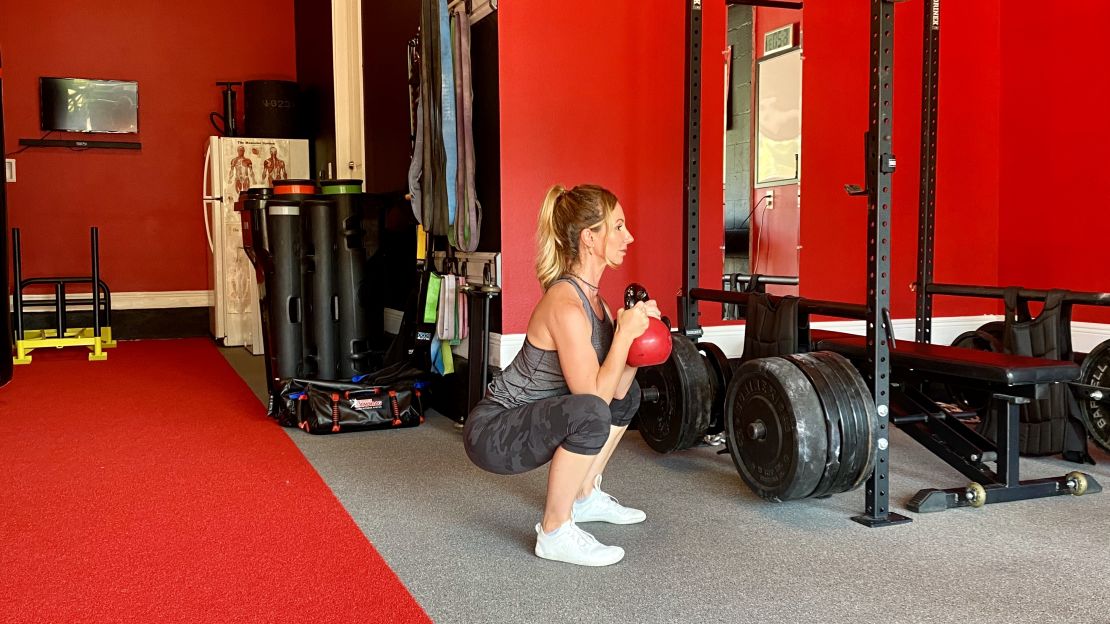
You can use either a kettlebell or dumbbell to perform this exercise. When selecting an appropriate weight, consider the heavy things you carry in daily life, like groceries, a child or a backpack. If you’re accustomed to carrying 10 to 20 or more pounds on a fairly regular basis, use a weight in that range for squatting. As you get stronger, add more weight and you’ll notice daily-life loads starting to feel lighter.
Stand with your feet slightly wider than hip-distance apart and toes pointed slightly out. Hold your kettlebell at chest height, gripping each side of the handle in each hand. Keep your arms close to your chest and elbows pointing down. If you’re using a dumbbell, hold it vertically, using both hands to cup the top end of the weight, like you’re cradling a goblet.
Inhale, keeping your chest up, back neutral and core braced. Squat as low as you can without discomfort or your back rounding. At the deepest point in your squat, pause, then drive through your heels, legs and glutes to stand back. Exhale at the top. Repeat for a total of eight to 12 repetitions.
READ MORE: How to reboot your workout routine: Let’s set the foundation
Half-kneeling dumbbell chop
This exercise relies on lower-body stability to support rotational core movement and upper-body strengthening in the transverse plane. Start with a lower weight in the 5- to 10-pound range and perfect your form before adding more weight.
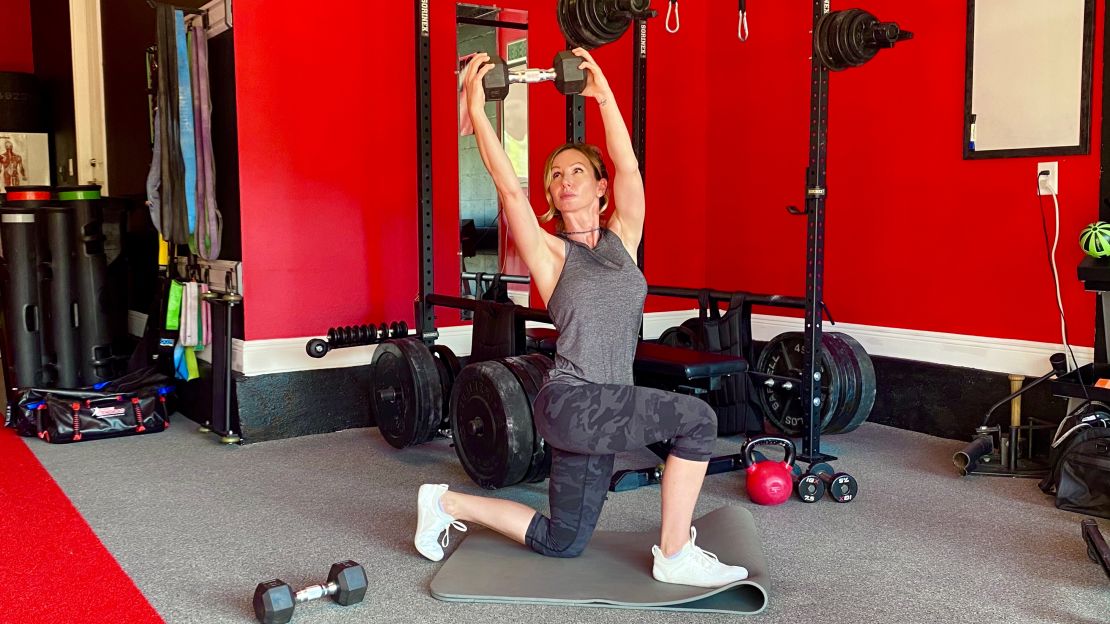
Begin in a kneeling lunge position with your left knee on the ground and right leg bent at 90 degrees with your ankle directly under your knee. Use a mat or towel to cushion your left knee, if needed. Hold both ends of the dumbbell in each hand in front of your left thigh.
Exhale as you pull the weight toward your chest, then press it diagonally above your right shoulder. Hips and legs stay facing forward as your rotate through your upper body. Pause at the top. Inhale as you slowly lower the weight back down to the starting position. Complete eight to 12 reps, then switch to the other side.
READ MORE: Master body-weight movements: How to reboot your workout routine
Single-leg Romanian deadlift
While strengthening the back of your legs, glutes and back muscles, this single-leg movement, also promotes balance and proper hip function. Use 5 to 15 pounds initially, mastering the movement before progressing to heavier weight.
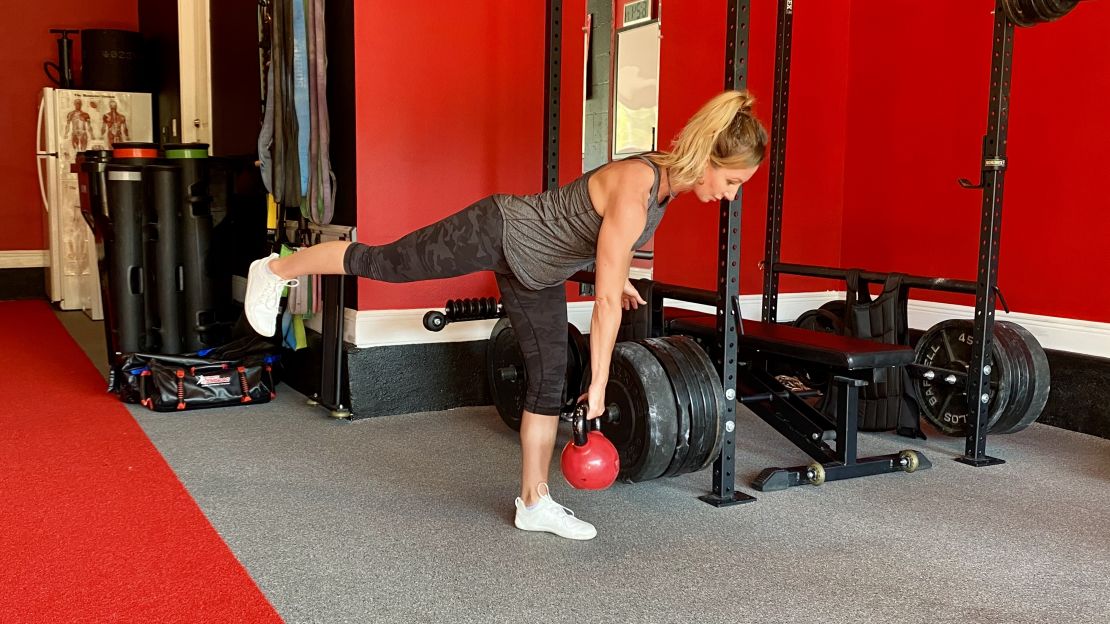
Stand holding a kettlebell or dumbbell in your right hand in front of your right thigh. Lift your right foot slightly, shifting your weight over your left foot. Keep your left leg straight but don’t lock out your left knee. Maintaining a soft bend increases stability.
Inhale as you move into the exercise by hinging forward with a flat back, extending your right leg straight behind you while lowering the dumbbell to shin level. Point your right foot and hip downward to avoid opening up to the side. Use your left arm as counterbalance. If you feel really wobbly, modify by placing your left hand on a wall or other stable surface.
Exhale as you drive through your left leg and hinge back up to standing. Repeat for eight to 12 reps then switch sides.
Seated overhead dumbbell press
This overhead pressing movement strengthens arms, shoulders, back and core. It’s important not to go too heavy, too soon. Start in the 10- to 20-pound (total weight) range.
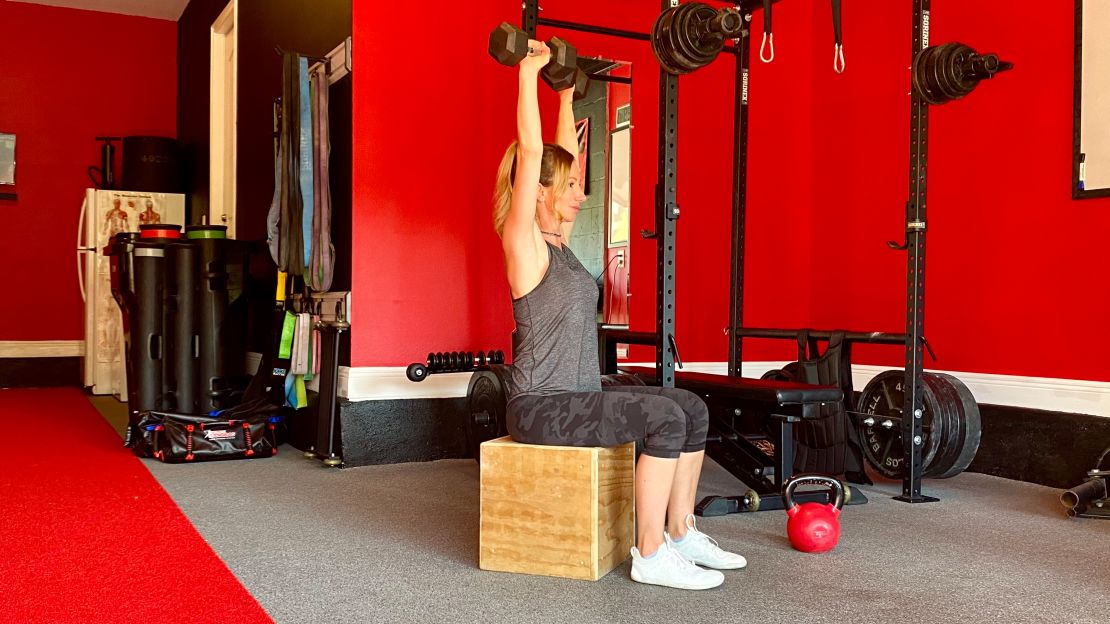
Begin seated with your feet on the floor hip-distance apart, toes pointed forward, torso upright and spine neutral. Using an overhand grip (palms facing forward and thumbs wrapped around the handles), hold the dumbbells in each hand just outside your shoulders. The weight should feel challenging but you should still be able to hold it with a straight, neutral wrist—no dipping forward or backward.
Exhale as you press the weights above your head, using the exhale to bring your ribs in, back and down, making sure that your core is tight without extending your back. Slowly lower the weights back down to shoulder height, pausing before completing the next rep. Repeat for eight to 12 reps.
Remember what you learned about the importance of proper breathing for proper posture in Part I, and maintain a focus on your breathing for core control to maintain form during every repetition.
Tall kneeling kettlebell hold
When we lift weights, our goal should not only be to increase strength in our movements, but also to increase our ability to stabilize good posture. This tall kneeling kettlebell hold focuses on using your breathing as a stabilizing force to create a neutral, stacked position with our shoulders, rib cage and hips. Start with a kettlebell between 10 to 20 pounds that is challenging for you but doesn’t make it impossible for you to maintain the position throughout all five breaths.
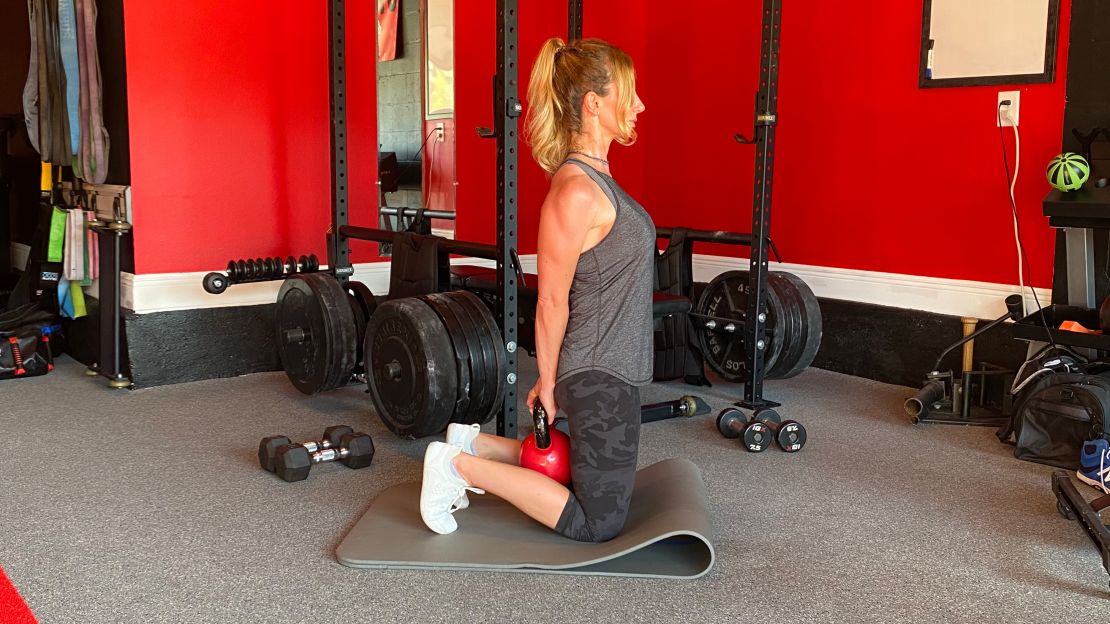
Place the kettlebell on your mat, then take a tall kneeling position in front of it with your back to the weight. Sit back on your heels and reach behind you with both hands to grab the handle of the kettlebell. Exhale as you engage your core and push your hips forward to lift the weight behind your back as you come up to the tall kneeling position. Your knees should be hip-distance apart and your toes curled forward with your heels up (as pictured).
Maintain vertical alignment of your shoulders, rib cage and hips over your knees without letting your back arch. As you hold the kettlebell behind you, keep your arms straight with your shoulders and chest open. It’s much harder than it looks!
Maintain this posture for five long, deep breaths, using your breathing to control your rib cage position. Strong exhales keep your rib cage down and stacked over your pelvis, while inhales expand your lower ribs out to the sides and back, preventing your spine from arching.
After five breaths, sit back on your heels to return the weight to the mat. Rest for 15 to 30 seconds and then repeat for another five breaths.
Dumbbell lateral raise
Remember, it’s important to exercise our bodies in all planes. The dumbbell lateral raise moves the weights out at the sides of our bodies, making it a frontal plane exercise. It works to strengthen our shoulders as well as the back muscles that support and control our shoulder movement. Use lighter dumbbells in the 3- to 7-pound range (each), enabling you to isolate your shoulders and avoid compensating with other muscles.
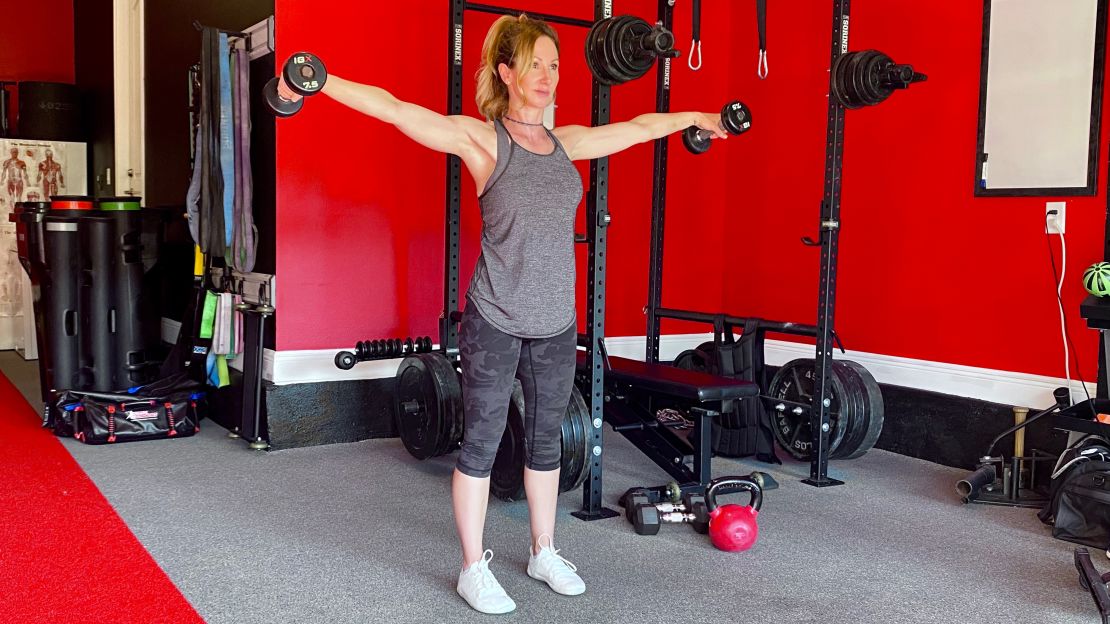
Begin standing with your feet hip-distance apart and a dumbbell in each hand at your sides, palms facing inward. Maintaining a very slight bend in your elbows for stability, exhale as you raise your arms out and up to shoulder level, making a T shape. Pause at the top.
Get CNN Health's weekly newsletter
Sign up here to get The Results Are In with Dr. Sanjay Gupta every Tuesday from the CNN Health team.
Inhale as you slowly lower the weights back to the starting position. Repeat for eight to 12 reps.
As you work on building your strength, you’ll find yourself moving with more confidence. Feeling good? You’re well on your way to rebooting your workout routine! That’s why next week, I’ll be sharing ways to get you moving faster with different forms of cardio.
Dana Santas, known as the “Mobility Maker,” is a certified strength and conditioning specialist and mind-body coach in professional sports, and is the author of the book “Practical Solutions for Back Pain Relief.”

